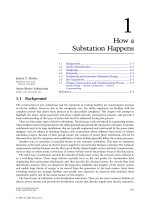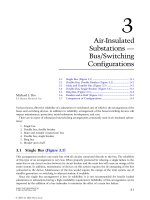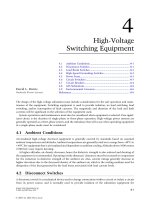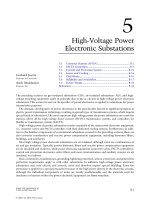electric power substations engineering (2)
Bạn đang xem bản rút gọn của tài liệu. Xem và tải ngay bản đầy đủ của tài liệu tại đây (656.49 KB, 11 trang )
ElECTRIC POWER
SUBSTATIONS
ENGINEERING
© 2003 by CRC Press LLC
© 2003 by CRC Press LLC
CRC PRESS
Boca Raton London New York Washington, D.C.
ElECTRIC POWER
SUBSTATIONS
ENGINEERING
Edited by
John D. McDonald
© 2003 by CRC Press LLC
The material from this book was Þrst published in
The Electric Power Engineering Handbook,
Grigsby, L.L., Ed., CRC
Press, Boca Raton, FL, 2001.
This book contains information obtained from authentic and highly regarded sources. Reprinted material is quoted with
permission, and sources are indicated. A wide variety of references are listed. Reasonable efforts have been made to publish
reliable data and information, but the authors and the publisher cannot assume responsibility for the validity of all materials
or for the consequences of their use.
Neither this book nor any part may be reproduced or transmitted in any form or by any means, electronic or mechanical,
including photocopying, microÞlming, and recording, or by any information storage or retrieval system, without prior
permission in writing from the publisher.
All rights reserved. Authorization to photocopy items for internal or personal use, or the personal or internal use of speciÞc
clients, may be granted by CRC Press LLC, provided that $1.50 per page photocopied is paid directly to Copyright Clearance
Center, 222 Rosewood Drive, Danvers, MA 01923 USA The fee code for users of the Transactional Reporting Service is
ISBN 0-8493-1703-7/03/$0.00+$1.50. The fee is subject to change without notice. For organizations that have been granted
a photocopy license by the CCC, a separate system of payment has been arranged.
The consent of CRC Press LLC does not extend to copying for general distribution, for promotion, for creating new works,
or for resale. SpeciÞc permission must be obtained in writing from CRC Press LLC for such copying.
Direct all inquiries to CRC Press LLC, 2000 N.W. Corporate Blvd., Boca Raton, Florida 33431.
Trademark Notice:
Product or corporate names may be trademarks or registered trademarks, and are used only for
identiÞcation and explanation, without intent to infringe.
Visit the CRC Press Web site at www.crcpress.com
© 2003 by CRC Press LLC
No claim to original U.S. Government works
International Standard Book Number 0-8493-1703-7
Library of Congress Card Number 2003043993
Printed in the United States of America 1 2 3 4 5 6 7 8 9 0
Printed on acid-free paper
Library of Congress Cataloging-in-Publication Data
Electric power substations engineering / edited by John D. McDonald.
p. cm. — (Electric power engineering series ; 8)
ISBN 0-8493-1703-7 (alk. paper)
1. Electric substations. I. McDonald, John D. (John David), 1951- II. Series.
TK1751.E44 2003
621.31—dc21 2003043993
1703_Frame_C00.fm Page iv Wednesday, May 14, 2003 1:08 PM
© 2003 by CRC Press LLC
v
Preface
The electric power substation, whether generating station or transmission and distribution, remains one
of the most challenging and exciting fields of electric power engineering. Recent technological develop-
ments have had tremendous impact on all aspects of substation design and operation. The objective of
Electric Power Substations Engineering
is to provide an extensive overview of the substation, as well as a
reference and guide for its study. The chapters are written for the electric power engineering professional
to give detailed design information, as well as for other engineering professions (e.g., mechanical, civil)
who want an overview or specific information in one particular area.
The book is organized into 18 chapters to provide comprehensive information on all aspects of
substations, from the initial concept of a substation to design, automation, operation, and physical and
cyber security. The chapters are written as tutorials, and most provide references for further reading and
study. The chapter authors are members of the Institute of Electrical and Electronics Engineers (IEEE)
Power Engineering Society (PES) Substations Committee, the group that develops the standards that
govern all aspects of substations. Consequently, this book contains the most recent technological devel-
opments regarding industry practice as well as industry standards. This work is a member of the Electric
Power Engineering Series published by CRC Press.
During my review of the individual chapters of this book, I was very pleased with the level of detail
presented and, more importantly, the tutorial writing style and use of photographs and graphics to help
the reader understand the material. I thank the tremendous efforts of the 25 authors who were dedicated
to do the very best job they could in writing the 18 chapters. I also thank the personnel at CRC Press
who have been involved in the production of this book, with a special word of thanks to Nora Konopka,
Helena Redshaw, and Michele Berman. They were a pleasure to work with and made this project a lot
of fun for all of us.
John D. McDonald
Editor-in-Chief
1703_Frame_C00.fm Page v Wednesday, May 14, 2003 1:08 PM
© 2003 by CRC Press LLC
vii
Editor-in-Chief
John D. McDonald, P.E.
, is senior principal consultant and
manager of automation, reliability, and asset management for
KEMA, Inc. In his over 29 years of experience in the electric
utility industry, McDonald has developed power application
software for both supervisory control and data acquisition
(SCADA) energy management system (EMS) and SCADA dis-
tribution management system (DMS) applications, developed
distribution automation and load management systems, man-
aged SCADA/EMS and SCADA/DMS projects, and assisted
intelligent electronic device (IED) suppliers in the automation
of their IEDs. He is currently assisting electric utilities in sub-
station automation, distribution SCADA, communication pro-
tocols, and SCADA/DMS. McDonald received his B.S.E.E. and
M.S.E.E. (power engineering) degrees from Purdue University,
and an M.B.A. (finance) degree from the University of Califor-
nia-Berkeley. He is a member of Eta Kappa Nu and Tau Beta
Pi, is a Fellow of IEEE, and was awarded the IEEE Millennium
Medal in 2000, the IEEE PES Award for Excellence in Power
Distribution Engineering in 2002, and the IEEE PES Substations Committee Distinguished Service Award
in 2003. In his 17 years of working group and subcommittee leadership with the IEEE PES Substations
Committee, he has led 7 working groups and task forces that published standards/tutorials in the areas
of distribution SCADA, master/remote terminal unit (RTU), and RTU/IED communications. He is
secretary of the IEEE PES, covice chair of IEEE Standards Coordinating Committee (SCC) 36, corre-
sponding member to IEC Technical Committee (TC) 57 Working Group (WG) 11, and the past chair of
the IEEE PES Substations Committee. McDonald is a member of the advisory committee for the annual
DistribuTECH Conference and the editorial board for the IEEE
Power & Energy
magazine, and he is a
charter member of
T&D World
magazine’s international editorial advisory board. The editor teaches a
SCADA/EMS/DMS course at the Georgia Institute of Technology, a substation automation course at Iowa
State University, and substation automation, distribution SCADA, and communications courses for the
American Public Power Association and for various IEEE PES local chapters as an IEEE PES distinguished
lecturer. McDonald has published 21 papers in the areas of SCADA, EMS, DMS, and communications,
and is a registered professional engineer (electrical) in California, Pennsylvania, and Georgia. He is
coauthor of the book,
Automating a Distribution Cooperative, from A to Z
, published by the National
Rural Electric Cooperative Association Cooperative Research Network (CRN) in 1999. He edited the
Substations Integration and Automation chapter, and authored the Substation Automation article for
the book,
Electric Power Engineering Handbook
, cosponsored by the IEEE PES and published by CRC
Press in 2000.
1703_Frame_C00.fm Page vii Wednesday, May 14, 2003 1:08 PM
© 2003 by CRC Press LLC
viii
Contributors
Michael J. Bio
E.P. Breaux Electrical, Inc.
Birmingham, Alabama
Philip Bolin
Mitsubishi Electric Power
Warrendale, Pennsylvania
James C. Burke
Baltimore Gas and
Electric Company
Baltimore, Maryland
Don Delcourt
BC Hydro
Burnaby, British Columbia
Canada
Martin Delson
KEMA, Inc.
Oakland, California
James W. Evans
The St. Claire Group
Grosse Pointe Farms, Michigan
Sheila Frasier
Southern Engineering
Atlanta, Georgia
Rulon Fronk
Consultant
Cerritos, California
David L. Harris
Waukesha Electric Systems
New Berlin, Wisconsin
Gerhard Juette
Siemens AG (retired)
Munich, Germany
Tonia Jurbin
BC Hydro
Burnaby, British Columbia
Canada
Richard P. Keil
Commonwealth Associates, Inc.
Dayton, Ohio
Tibor Kertesz
Hydro One Networks Inc.
To ronto, Ontario
Canada
Hermann Koch
Siemens
Erlangen, Germany
John D. McDonald
KEMA, Inc.
Duluth, Georgia
Asok Mukherjee
Siemens AG
Erlangen, Germany
Daniel E. Nordell
Consulting Engineer
Minneapolis, Minnesota
Robert S. Nowell
Georgia Power Company
Atlanta, Georgia
John Oglevie
Power Engineers
Boise, Idaho
Pat Rooney
Rooney Protective Consulting
Group
Carney, Maryland
Anne-Marie Sahazizian
Hydro One Networks Inc.
To ronto, Ontario
Canada
James H. Sosinski
Consumers Energy
Jackson, Michigan
R.P. Stewart
BC Hydro
Burnaby, British Columbia
Canada
C.M. Mike Stine
Tyco Electronics-Energy Division
Tr acy, California
Joseph Weiss
KEMA, Inc.
Cupertino, California
1703_Frame_C00.fm Page viii Wednesday, May 14, 2003 2:17 PM
© 2003 by CRC Press LLC
ix
Contents
1
How a Substation Happens
James C. Burke and Anne-Marie Sahazizian
1.1 Background
1
-1
1.2 Needs Determination
1
-2
1.3 Budgeting
1
-2
1.4 Financing
1
-2
1.5 Traditional and Innovative Substation Design
1
-2
1.6 Site Acquisition
1
-3
1.7 Design, Construction, and Commissioning Process
1
-3
2
Gas-Insulated Substations
Philip Bolin
2.1 SF
6
2
-1
2.2 Construction and Service Life
2
-2
2.3 Economics of GIS
2
-17
3
Air-Insulated Substations — Bus/Switching Configurations
Michael J. Bio
3.1 Single Bus (Figure 3.1)
3
-1
3.2 Double Bus, Double Breaker (Figure 3.2)
3
-2
3.3 Main and Transfer Bus (Figure 3.3)
3
-2
3.4 Double Bus, Single Breaker (Figure 3.4)
3
-3
3.5 Ring Bus (Figure 3.5)
3
-4
3.6 Breaker-and-a-Half (Figure 3.6)
3
-5
3.7 Comparison of Configurations
3
-5
4
High-Voltage Switching Equipment
David L. Harris
4.1 Ambient Conditions
4
-1
4.2 Disconnect Switches
4
-1
4.3 Load Break Switches
4
-2
4.4 High-Speed Grounding Switches
4
-2
4.5 Power Fuses
4
-3
4.6 Circuit Switchers
4
-3
4.7 Circuit Breakers
4
-4
4.8 GIS Substations
4
-6
4.9 Environmental Concerns
4
-6
1703_Frame_C00.fm Page ix Wednesday, May 14, 2003 1:08 PM
© 2003 by CRC Press LLC
x
5
High-Voltage Power Electronic Substations
Gerhard Juette and
Asok Mukherjee
5.1 Converter Stations (HVDC)
5
-2
5.2 FACTS Controllers
5
-5
5.3 Control and Protection System
5
-10
5.4 Losses and Cooling
5
-16
5.5 Civil Works
5
-16
5.6 Reliability and Availability
5
-17
5.7 Future Trends
5
-18
6
The Interface between Automation and the Substation
James W. Evans
6.1 Introduction
6
-1
6.2 Physical Considerations
6
-2
6.3 Analog Data Acquisition
6
-4
6.4 Status Monitoring
6
-10
6.5 Control Functions
6
-11
6.6 Communications Networks inside the Substation
6
-14
6.7 Testing Automation Systems
6
-17
6.8 Summary
6
-20
7
Substation Integration and Automation
John D. McDonald
7.1 Introduction
7
-1
7.2 Definitions and Terminology
7
-2
7.3 Open Systems
7
-2
7.4 Architecture Functional Data Paths
7
-3
7.5 Substation Integration and Automation System Functional Architecture
7
-3
7.6 New vs. Existing Substations
7
-3
7.7 Equipment Condition Monitoring
7
-4
7.8 Substation Integration and Automation Technical Issues
7
-5
7.9 Protocol Fundamentals
7
-13
7.10 Protocol Considerations
7
-14
7.11 Choosing the Right Protocol
7
-17
7.12 Communication Protocol Application Areas
7
-17
7.13 Summary
7
-18
8
Oil Containment
Anne-Marie Sahazizian and Tibor Kertesz
8.1 Oil-Filled Equipment in Substation [IEEE 980-1994 (R2001)]
8
-2
8.2 Spill Risk Assessment
8
-3
8.3 Containment Selection Consideration [IEEE 980-1994 (R2001)]
8
-4
8.4 Oil Spill Prevention Techniques
8
-5
1703_Frame_C00.fm Page x Wednesday, May 14, 2003 1:08 PM
© 2003 by CRC Press LLC
xi
9
Community Considerations
James H. Sosinski
9.1 Community Acceptance
9
-1
9.2 Planning Strategies and Design
9-2
9.3 Permitting Process 9-10
9.4 Construction 9-11
9.5 Operations 9-12
9.6 Defining Terms (IEEE, 1998) 9-13
10 Animal Deterrents/Security C.M. Mike Stine and Sheila Frasier
10.1 Animal Types 10-2
10.2 Mitigation Methods 10-3
11 Substation Grounding Richard P. Keil
11.1 Reasons for Substation Grounding System 11-1
11.2 Accidental Ground Circuit 11-2
11.3 Design Criteria 11-8
12 Grounding and Lightning Robert S. Nowell
12.1 Lightning Stroke Protection 12-1
12.2 Lightning Parameters 12-2
12.3 Empirical Design Methods 12-5
12.4 The Electrogeometric Model (EGM) 12-7
12.5 Calculation of Failure Probability 12-18
12.6 Active Lightning Terminals 12-20
13 Seismic Considerations R.P. Stewart, Rulon Fronk, and Tonia Jurbin
13.1 Historical Perspective 13-1
13.2 IEEE 693 — a Solution 13-1
13.3 Relationship between Earthquakes and Substations 13-2
13.4 Applicable Documents 13-2
13.5 Decision Process for Seismic Design Considerations 13-3
13.6 Performance Levels and Required Spectra 13-3
13.7 Qualification Process 13-10
14 Substation Fire Protection Don Delcourt
14.1 Fire Hazards 14-1
14.2 Fire Protection Measures 14-4
14.3 Fire Protection Selection 14-5
14.4 Conclusion 14-7
Substation Control Building Fire-Protection-Review Checklist 14-8
Substation Switchyard Fire Protection Assessment Process 14-9
1703_Frame_C00.fm Page xi Wednesday, May 14, 2003 1:08 PM
© 2003 by CRC Press LLC
xii
15 Substation Communications Daniel E. Nordell
15.1 Introduction 15-1
15.2 Supervisory Control and Data Acquisition (SCADA) Historical Perspective 15-2
15.3 SCADA Functional Requirements 15-4
15.4 SCADA Communication Requirements 15-4
15.5 Components of a SCADA System 15-5
15.6 SCADA Communication Protocols: Past, Present, and Future 15-6
15.7 The Structure of a SCADA Communications Protocol 15-9
15.8 Security for Substation Communications 15-11
15.9 Electromagnetic Environment 15-14
15.10 Communications Media 15-15
15.11 Additional Information 15-22
16 Physical Security John Oglevie and Pat Rooney
16.1 Introduction 16-1
16.2 History 16-2
16.3 Types of Intruders 16-3
16.4 Substation Development 16-4
16.5 Security Methods 16-5
16.6 Security Assessment 16-11
17 Cyber Security of Substation Control and Diagnostic Systems
Joseph Weiss and Martin Delson
17.1 Introduction 17-1
17.2 Definitions and Terminology 17-2
17.3 Threats to the Security of Substation Systems 17-3
17.4 Substation Automation (SA) System Vulnerabilities 17-4
17.5 Measures to Enhance Cyber Security 17-6
17.6 Devising a Security Policy 17-11
17.7 Future Measures 17-12
18 Gas-Insulated Transmission Line (GIL) Hermann Koch
18.1 Introduction 18-1
18.2 History 18-2
18.3 System Design 18-3
18.4 Development and Prototypes 18-9
18.5 Advantages of GIL 18-21
18.6 Application of Second-Generation GIL 18-25
18.7 Quality Control and Diagnostic Tools 18-27
18.8 Corrosion Protection 18-28
18.9 Voltage Stress Coming from the Electric Power Net 18-30
18.10 Future Needs of High-Power Interconnections 18-32
1703_Frame_C00.fm Page xii Wednesday, May 14, 2003 1:08 PM
© 2003 by CRC Press LLC









